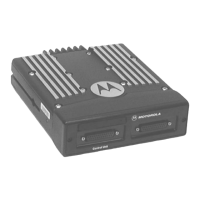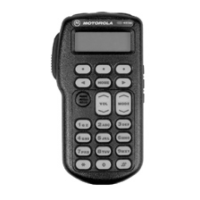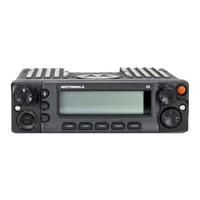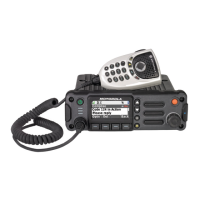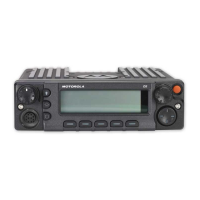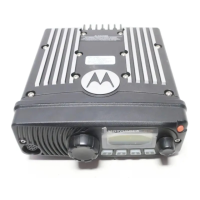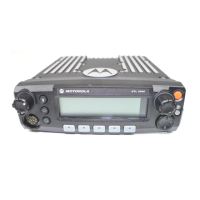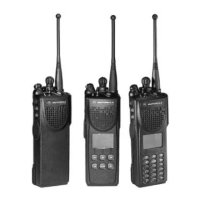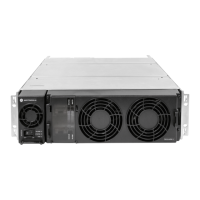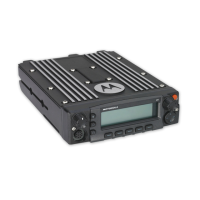6881076C25-E September 5, 2008
Theory of Operation: Power Amplifiers 3-71
The collector current of the high-power amplifier is monitored by sensing the voltage across R5875.
CURRENT SENSE + connects to one end of R5875; CURRENT SENSE - connects to the other end.
These lines connect to the command board on U500 pins 37 and 38, respectively. If the TX
CURRENT LIMIT is set for 1.5 V, then the voltage difference between U500 pins 37 and 38 must be
0.1 V before the current through R5875 is reduced. If U500 pin 40 is programmed for 4.5 V, then the
difference of potential between pins 37 and 38 must exceed 0.3 V before current limiting begins. The
voltage across R5875, where current sense occurs, can be determined by multiplying the voltage on
U500, pin 40 by 0.067. When current is being limited, the output of the op-amp (U500, pin 42) begins
shutting down the conduction of Q503 and Q504, reducing PA control voltage, and reducing drive to
the final amplifier to, effectively, control the final amplifier's maximum current.
Forward Power Limiter
After the harmonic filter a parallel pair of microstrip lines form a forward power sensing directional
coupler and detector. The output of this directional coupler/detector is a DC voltage that is
proportional to the forward RF power from the final amplifier. During normal transmission, the DC
voltage from the forward detect line to the RPCIC ranges from 2 to 5.0 V.
This voltage connects to U500 pin 9, the directional coupler buffer input.
The directional coupler's buffered output, U500 pin 8, is summed to pin 2 with the digital/analog
buffer's output through R509 and R507, respectively. In typical operation, the closed loop operation
of the circuit attempts to keep the voltage at U500 pin 2 a constant value of 3.2 V. The control amp
will maintain this condition by increasing or decreasing the control amp output voltage. This control
amp output voltage is routed to the LLA via transistors Q503 and Q504. The output of Q504 is
designated "control voltage drive" and is routed to J1 pin 2 of the PA board.
Since control voltage drive controls the gain of the LLA, it determines the drive level to the following
stages and thus the output power of the final amplifier. The output power of the final stage is
detected by the directional coupler and is routed back to U500 pin 2 via the buffer and R507. Thus
the loop is complete and forward power is maintained a constant value. The voltage at pin 2 will drop
below 3.2 V during low line voltage conditions where the PA cannot produce rated power. Current
limit and voltage control limit circuits will also affect the voltage at pin 2 as described in the following
discussion on temperature sensing.
Temperature Sensing
The temperature-sensing circuit of the PA works with the RPCIC to protect the PA devices from
excessively high temperatures. On the PA board, this circuit, (formed by resistors R5857, R5843,
R5858, and thermistor RT5875), provides a temperature dependent voltage to the RPCIC via J1 pin
6. As the PA temperature increases, the resistance of RT5875 decreases, causing the voltage at pin
6 to increase. This voltage is routed to the RPCIC, U500 pin 13, which is the input to the thermistor
buffer. The buffer's output on pin 12 is connected to pin 2 via resistor R508. Note that pin 2 is the
control amp input and is a summing point for temperature, forward-power detect, and power set
signals. If the PA temperature becomes high enough so that the voltage at pin 7 exceeds 3.2 V, the
thermistor buffer starts supplying current to the node at pin 2. Due to the fixed output current of the
power-set buffer, the control loop can maintain 3.2 V at pin 2 only by reducing the forward-power
detect voltage and, therefore, reducing the PA output power. Since power output is reduced, the
generated heat is reduced to a safe level. If temperature decreases, the power output of the PA
gradually increases to its nominal value.
NOTE: Under severe environmental conditions, more than one circuit may be attempting to reduce
power output at the same time (i.e., during high VSWR conditions, the current limiter may
initially reduce power, but eventual heat buildup will cause further power reduction by the
thermal cut-back circuit).
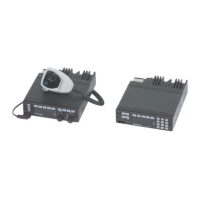
